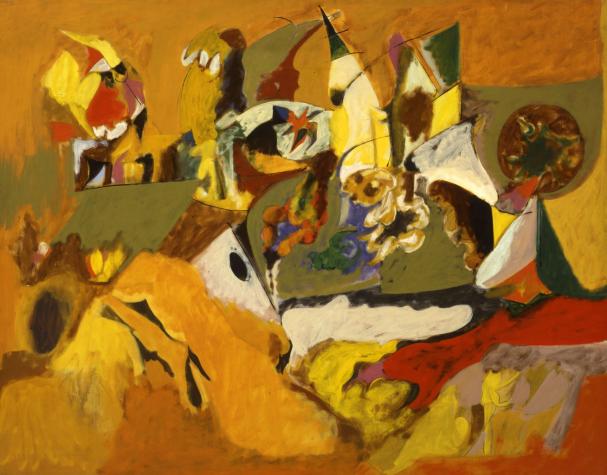Description
The "golden brown paint" by Arshile Gorky, created in 1944, is located at a significant crossing within the development of modern art, where the emotional and the abstract converge. This work, a powerful representation of the artist's concerns and aspirations, encapsulates the essence of an era marked by the search for identity and the transposition of personal experiences through pictorial language.
When observing the paint, the first thing that stands out is its master use of color. The golden brown, which gives name to the work, covers the canvas with a rich and enveloping depth that suggests both a warmth and a melancholy. This nuance is complemented by a nuanced palette that includes darker tones and dynamic brush marks, generating a sensory atmosphere that invites the viewer to enter an inner world. The apparent simplicity of the palette becomes a vehicle for emotional complexity, a distinctive seal of Gatchy's style.
The composition is an intertwined of organic forms that seems to evoke a kind of dance between chaos and order. In the upper part, elements that suggest biomorphic forms flow and intertwine, while in the lower part, more solid and anchored shapes seem to react to the movements of the upper space. This dialogue between the light and the heavy, the fleeting and the perennial, translates into a visual experience that highlights the duality of existence.
The work reflects the influence of surrealism, a movement that Gorky assimilated in his own vocabulary. Although specific figures or characters are not identified more than literally, there is a clear insinuation of the human figure that can be found in the structure of the forms. This ambiguity feeds a sense of introspection and connection. The lack of a clear narrative allows each observer to project their own experience in the work, making the "golden brown painting" a university experience that transcends its historical and cultural specificities.
Gatchy, a pioneer of abstract expressionism, uses gestures as a means to explore the subconscious, an approach that becomes evident in this work. Inspired by his own experiences, including his exile and personal tragedies, came to transform his anguish into a visual praise to creation. This intersection between the personal and the universal, the psychological and the formal, is what makes the work resonate powerfully, both in its historical context and in its enduring aesthetic impact.
The "golden brown paint" also resonates with other works by Gorky, where the same game of soft and evocative forms is present. However, this piece, in particular, establishes a milestone in its personal and artistic evolution, marked by the use of matter and color as extensions of its essence. As part of the symbolism of his legacy, the work is a testimony of his technical skill and his ability to translate the ephemeral of the human condition in a enduring visual language.
In conclusion, "golden brown painting" is not only a reflection of Gorky's individual experiences, but also a meditation on the creation, loss and search for a sense in a chaotic world. It is a work that invites multiple readings and that persists as a porch to understand interrelated pain and beauty, an approach that characterizes its contributions to the art of the twentieth century. The appreciation of this piece is ultimately offers, a call to introspection and personal aesthetic experience, a legacy that continues to vibrate in contemporary art.
KUADROS ©, a famous paint on your wall.
Hand-made oil painting reproductions, with the quality of professional artists and the distinctive seal of KUADROS ©.
Art reproduction service with satisfaction guarantee. If you are not completely satisfied with the replica of your painting, we refund your money 100%.

